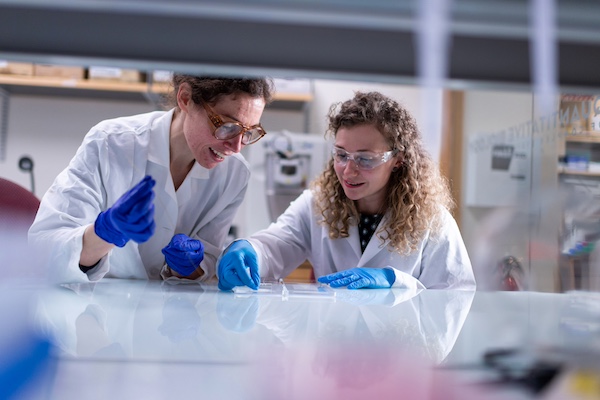Morgridge postdoc aims to discover the molecular machinery that will paralyze a deadly parasite
Andrés Tibabuzo’s scientific curiosity was sparked as a child watching the movie “Jurassic Park” and grew to encompass the study of snake venom, the adhesion of marine creatures to underwater objects and the biology of parasites.
“I remember watching ‘Dexter’s Lab’ in Saturday morning cartoons and dreaming of having a secret lab that I could access through my closet,” recalls Tibabuzo, today a postdoctoral fellow in the lab of Morgridge Institute for Research investigator Phillip Newmark.
Tibabuzo developed an interest in venomous snakes after studying them in high school. As a biology student at the Universidad de los Andes in his native Colombia, he focused understanding the mechanics of a compound in venom called phospholipase.
From there, Tibabuzo changed gears, entering a chemistry Ph.D. program at Purdue University, where he worked to understand the origins and chemistry of bioadhesion in shellfish.
“My plan going into a Ph.D. was to learn more techniques to translate basic science into something that could be useful in the future,” he says.
Mussels and oysters can adhere underwater, and the overarching goal of the research was to determine whether imitating that process could develop a material to help heal wounds and broken bones in humans.
After earning his doctorate in 2019, Tibabuzo was contacted by a postdoc friend at the University of Georgia who suggested he look into doing work for University of Wisconsin–Madison Professor Laura Knoll.
Tibabuzo landed the position and worked for a year studying the mechanisms that trigger the intracellular parasite Toxoplasma gondii to undergo sexual development in the guts of cats. But the COVID-19 pandemic derailed that job, as Tibabuzo encountered a multitude of visa issues that kept him out of the lab.
Eventually, the disruptions forced Tibabuzo and Knoll to part ways. But while he was in Knoll’s lab, he met his future wife, Gina Gallego-Lopez, who is now a postdoc in Morgridge investigator Melissa Skala’s biomedical optical imaging lab.
Finally, in August 2022, the immigration issues were settled and Tibabuzo jump-started his postdoc career with Morgridge regenerative biology investigator Phil Newmark.
As a member of the Newmark/Issigonis Lab, Tibabuzo is working to understand the biology of the flatworm Schistosoma mansoni. Schistosomes are parasites that cause schistosomiasis, a major and neglected tropical disease that affects hundreds of millions of people, especially in Africa.
These worms have a complex life cycle that requires the presence of a snail to produce the infective form of the parasite that affects humans. Previous research in the Newmark/Issigonis Lab showed that a small invertebrate that lives in the shell of the snails produces a compound that can paralyze the parasites.
Tibabuzo says the research is aimed at finding the mechanism involved in the paralysis of the parasite. “If we know the mechanism, then we can either develop drugs or other techniques to avoid the infection in the first place,” he says.
For students considering a doctoral track, Tibabuzo advises that they pursue research that fascinates them.
“It makes the whole difference when you’re highly motivated. It will help you get through the points in research when things are not working,” Tibabuzo says. “It’s really a powerful way to get you through.”
As for his own motivation, Tibabuzo points to curiosity, constant learning and a capacity to solve problems.“I love learning,” he says. “I love working with new systems, but I also find that I like troubleshooting and making things work.”

Rising Sparks: Early Career Stars
Rising Sparks is a monthly profile series exploring the personal inspirations and professional goals of early-career scientists at the Morgridge Institute.

